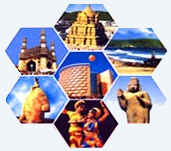HISTORY OF ANDHRA PEOPLE
Andhra society is one of the ancient societies of India, with tales about Andhras found in epics like Mahabharatam and Ramayanam, great puranas, and Buddhist Jataka Tales. This confirms the ancient nature of Andhra society.
According to some experts, Andhras and Kalingas (ka’Limgulu) supported the Kauravas during the battle between Kauravas and Pandavas (the Bharata yudhdham). Sahadeva defeated the kingdoms of Pandya, Dravida, Odhra, Kerala, Andhra, and Kalinga while performing the Rajasooya yajna, as depicted in the Mahabharatam. Chanoora (ca’NooruDu) was killed by Srikrishna in Madhura. Harivamsapuranam corroborates that Chanoora was the king of Karoosa Desa (karooSa dESam) (on the North side of Vindhya and on the North banks of the Yamuna river and was an Andhra (Andhrudu) too

Ramayanam depicts an interesting tale. Viswamitra condemned the “Naramedha Yagam,” freed Sunassepu (SunaSSEpu, the yajna paSuvu), and adopted him as his son. Viswamitra’s children disliked this act by their father and were cursed. Then Viswamitra’s children migrated towards east and south. It is understood from this tale that these children of Viswamitra were Andhras (a’mdhrulu).
A tribe called “Andhras” arrived at the banks of Yamuna river during the Mahabharata war (1500 BC), as described in the epic.
The Mahabharata war holds a prominent place in ancient history, with numerous kings of different tribes fighting in this battle. Kauravas were destroyed, and innumerable tiny kingdoms mushroomed. Locust infestation destroyed crops on the banks of Ganges and Yamuna rivers, leading to people inhabiting those regions migrating 300 miles away to the south. Chandogyopanishat (Ca’mdOgyOpanishad) confirms this. Iatreya (aitarEya bra’hmaNam) Brahmanam tells us that Andhras lived on the south side of Vindhya along with Pundrapulinda Sabara Mootibas (punDrapulimda Sabara mootibulu). Chandogyopanishad and Itareya Brahmanam were written in 1000 BC.
Andhras were nomads for several centuries. Some tribes (classes) migrated, and others did not want to, remaining in their older settlements. During 700 BC, some Andhra tribes inhabited Salvadesa (sa’lvadESamu) on the banks of the Yamuna River, as explained in the tale of Apastambarushi
(a’pastambaRushi). Apastamba rules (a’pastamba gruhya sootra’lu) have been widely practiced among Andhra Brahmin families today. A single Rishi was the teacher (a’ca’rya) of each tribe, and Apastamba was one such teacher who wrote these rules in Salvadesam on the banks of the Yamuna river. After Apastamba’s death, the Andhra tribes crossed the Vindhya mountains, reached the South, and merged with other Andhra tribes.
Some of those Andhras who came to the south settled on the west side of Vindhya mountains (present Northern regions of Hyderabad). Another tribe crossed the Eastern Ghats over Orissa and reached the Kalinga Desam. The “Serivanijo” Jataka tale explains that Andhras built “ANDHAKAPURAM” on the banks of the “Tel” (tEl) river.
Jataka tales were written during 200-250 BC. The Tel river is a subriver of Mahanadi in Orissa, confirming that one of the Andhra tribes migrated this way. The people in this tribe are Kalingas (ka’Limgulu). The books cited above describe the Andhras and Kalingas as two different branches of a single tribe, with the terms Andhras and Kalingas sometimes used interchangeably.
Andhra tribes established relationships with Naga, Yaksha, and Dravida tribes of Vindhya mountains who already lived there then. Telugu, Tamil, and Kannada are Dravidian languages. Rayalaseema was the first settlement of Tenugu people, later occupied by Telangana. The name “Tenugu” transformed into “Telugu,” giving rise to words like “Telagalu,” “Telangana,” “Telanganyulu” (a subsect of Andhra Brahmins), and “Teligiri.” A tribe called “Tailang” (taila’ng) in Burma is proposed to be related to Telugu people.
Tenugu (tenugu) is the meaning for those who travel towards the south. In Tamil and Kannada, the term “ten” corresponds to the south side (dakshina dikku)